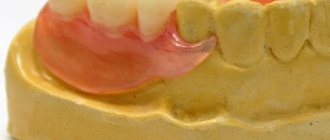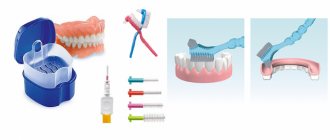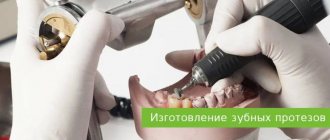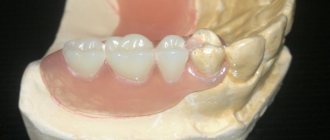The loss of even one tooth in a row can lead to serious negative consequences for the health of the oral cavity as a whole, so it is necessary to solve the problem and restore lost dental units immediately. To restore lost teeth, modern dentistry offers different types of procedures - prosthetics and implantation. The greatest demand among patients is for more affordable prosthetics, which can involve both fixed and removable types of dentures.
In terms of durability and strength of fixation, the best option would be fixed dentures, but their installation is not always possible, and then removable dentures can help restore the beauty of your smile. However, such orthodontic structures are available in a wide range, and sometimes the patient finds it difficult to choose a specific type of product for prosthetics. This article is designed to help you find out all the useful details about removable dentures, and we will start with a detailed overview of all existing types of removable dentures.
Removable dentures: definition and classification
Orthodontic products for prosthetics can be either removable or non-removable. The key difference between the designs is that by choosing a removable denture, you can always either remove or put it on without the help of a specialist. Removable dentures have their own gradation into individual varieties, which is important to get acquainted with - this will help you make the right choice of a specific type of product. First of all, you should know that there are separate types of removable dentures for complete and single restoration.
Dentures for restoration with complete edentia
Complete restoration of the dentition is necessary when all teeth have been lost and a complete removable denture is used for it, which allows you to effectively solve the problem of tooth loss, but keep in mind that such designs do not differ in reliability and long useful life, and especially the so-called soft orthodontic products - from plastic or nylon.
The rapid wear of the prosthesis is explained by the fact that with a complete restoration it is not possible to achieve coordinated work of the masticatory muscles: the main pressure will be exerted on the mucous and gingival part of the oral cavity and cause a decrease in the natural volume of the tissues of the jaw joint. As a result of this effect, the height of the gums will gradually decrease, and this process will ultimately lead to the fact that the old prosthesis simply will not stay on the installation bed. Moreover, the incorrect position of the removable denture in the mouth will provoke manifestations of pain when eating or actively talking.
Full removable orthodontic products are not the best option for restoring lost teeth because they cannot be properly fixed in the oral cavity and, especially, in the lower jaw area. Even the use of special adhesive gels will not give you a guarantee that the removable denture will not fall out of its place at the most inopportune moment. In such cases, dentists advise not to save money and initially carry out restoration with removable dentures on implants, which we will discuss in detail below.
USEFUL FACT: Removable dentures do not stop the process of bone tissue atrophy and, on the contrary, accelerate its progress. As the bone volume decreases, the denture will no longer stay in place and will require replacement. This is another reason why it is recommended to replace a removable orthopedic structure with a non-removable product as quickly as possible.
Removable dentures for partial dentures
If the patient has preserved teeth in the rows and these units are absolutely healthy, for restoration it is optimal to select one of the existing types of removable orthodontic systems for partial dentures.
In partial prosthetics, dentists use structures equipped with a special type of fastener - clasps. At their core, clasps are miniature locks that are attached to the jaw. The elements are made from fairly strong metal wire, which guarantees reliable fixation of the removable denture.
It is important to understand that partial dentures are only possible if there are units in the dentition that can be used as support for the installation of a removable denture. Another important nuance that must be taken into account when selecting a prosthesis for restoration with a single edentia is that not all types of structures are aesthetic in appearance and therefore they are not recommended for installation in the smile area.
Classification of removable dentures in dentistry is also carried out according to the material of their production. The material used to make an orthodontic product is one of the key criteria for the proper selection of a removable denture, since such important indicators as the comfort of use of the structure, its reliability and durability depend on it. Below we will consider in detail all types of removable dentures based on the material used.
Installation Features
Removable structures have a base that imitates natural gums. Therefore, they look natural, like natural teeth.
In case of complete edentia, the removable denture is attached directly to the gums. The prosthesis fits tightly to the soft tissues, without displacement or loosening.
The prosthesis is fixed using clasps, hooks or implants. The lower part is attached to the roots of the natural teeth, and the upper part is attached inside the base of the structure. If the prosthesis replaces the entire dentition, then fixation occurs only on the gums.
Plastic or acrylic removable dentures
Acrylic or plastic removable dentures are inexpensive and easy to manufacture and use. For their production, a special type of acrylic plastic is used, characterized by increased characteristics of strength, hygiene and hypoallergenicity. The product is fixed to the jaw with soft valves, which are more colloquially referred to as “suction cups”. Naturally, the quality of fixation leaves much to be desired - the soft fastening element does not ensure reliable adhesion of the structure and tissues of the oral cavity.
If you have chosen a removable prosthesis with valves, be sure to make sure of the quality of its manufacture. This can be done using a simple test: having installed the denture in your mouth, try to bite something with it. If you feel air escaping from under the removable denture, it means it is made with high quality and will be comfortable to use.
An acrylic prosthesis will not cause pain during use if its base fits tightly to the gums. Otherwise, the chewing load will be placed on the soft tissues, which will cause a process of gradual atrophy and then deformation of the orthodontic structure itself.
Expert advice: Order the production of an acrylic removable denture with an individual impression tray - this will guarantee a tight fit of the structure to the tissues of the jaw and ensure its most reliable fixation on the jaw.
The advantages of removable acrylic dentures include the following qualities:
- The design is manufactured quickly and simply, which makes its cost as affordable as possible for patients.
- Acrylic removable dentures are easily repaired and restored if broken or damaged.
However, acrylic products also have a number of disadvantages, which are important to study before choosing this type of removable dentures. Professionals call the main disadvantage of plastic structures the fact that when installed in the oral cavity, the base of a removable denture will block the palate and this often causes such undesirable consequences as diction disorders and a decrease in the natural sensitivity of taste buds.
Removable acrylic dentures cannot be used for prosthetics in the lower jaw area, since there is no way to firmly fix the structure on the gums. Without reliable fixation, there is a risk that the prosthesis will fall out during eating or active dialogue. Inexpensive removable dentures made of acrylic do not differ in durability. The product will have to be replaced with a new one every two to three years, since plastic is a material prone to deformation. The useful life of a removable acrylic prosthesis may be shorter in situations where the process of reducing the volume of bone tissue in a patient occurs at an accelerated pace.
If we talk about the exact cost of the service for the manufacture and installation of a plastic prosthesis, it will depend on the type of product and the need for additional procedures before prosthetics. You can get a detailed consultation on removable prosthetics at any time convenient for you at our dentistry in Moscow - VENSTOM (located next to the Baumanskaya metro station).
All-on-4 design. Prostheses with bar fixation
The essence of this prosthetics is in its name. It involves the installation of a complete denture on one jaw on 4 implant supports. Implants are implanted in an inclined plane; the prosthetic process does not take much time. This prosthesis does not affect changes in taste sensations or diction.
The advantages of such a prosthesis are high aesthetics, second only to classical implantation, reliable fixation, uniform load distribution, a short period of adaptation, the ability to choose a convenient design, and no need for bone grafting.
Disadvantages: high cost compared to removable dentures; the prosthesis still feels more like a prosthesis, and not like your own teeth.
Removable dentures made of nylon in Moscow
Another budget option for orthodontic structures for removable prosthetics are removable nylon dentures. Already from the name of the products it is clear that they are made from nylon - a soft polyamide with increased elasticity. This type of construction is applicable in both complete and single prosthetics. In the production of removable dentures, biocompatible and hypoallergenic nylon is used, which does not change color and properties under the influence of various external aggressive factors.
Dental nylon has a non-porous structure, which prevents the penetration of pathogenic microorganisms into the prosthesis. This quality distinguishes removable nylon dentures from products made of acrylic and other types of plastic. Nylon structures are fixed to the gums, where the base of the removable denture is fixed with special locks. Fastening elements are also made of nylon (less commonly, silicone) and therefore they remain inconspicuous against the background of the natural tissues of the oral cavity. Nylon clasps help to obtain the tightest possible fit of the removable denture to the bed, which is necessary for reliable fixation of the product in the mouth.
Among the advantages of removable dentures made of nylon are the comfortable anatomical shape of the products, compact size and low weight. These characteristics facilitate the process of adaptation to the design and reduce the risk of pain during the use of a removable denture. But orthodontic products made of nylon have not only advantages, but also a significant number of disadvantages:
1. A removable nylon denture does not provide coordinated work of the masticatory muscles and therefore excessive pressure occurs in the oral cavity on the soft tissues and mucous membranes. Constant loads on soft tissues and jaws accelerate the process of receding gums and reducing the volume of bone tissue.
2. Increased flexibility of the design leads to the fact that some of its elements will work more when chewing food, while others will work less. The result of uneven load is the patient’s discomfort while eating and fairly rapid wear of the removable denture.
3. Over time, the removable nylon denture sags and this phenomenon is fraught with inflammation in the oral cavity.
4. The surface of the product is rough and therefore plaque accumulates on the prosthesis, stone is formed, and an unpleasant odor may appear from the mouth.
Also, the disadvantages of removable dentures made of nylon include the significant time consumption for manufacturing the structure and the need for frequent and regular visits to the dentist for hygienic procedures to sanitize the denture base and the oral cavity.
Which removable dentures are better – acrylic or nylon? Comparison of designs and reviews from experts
What type of dentures is better - nylon or acrylic? Patients often turn to dentists with this question, finding it difficult to make a choice on their own. The answer to this pressing question will depend on in which area of the oral cavity restoration is required and what kind of restoration it will be - complete or partial.
If it is necessary to carry out prosthetics with complete edentia, then it is more advisable to opt for acrylic removable dentures - they stay in the oral cavity better due to the “suction cup” effect. But nylon and acrylic removable dentures are equally poorly suited for restoration in the area of the lower jaw bone - the products simply cannot be firmly fixed in this area. Therefore, here it is best to consider a fundamentally different type of structure - clasp dentures or dentures on implants. Nylon prostheses are inferior to plastic structures in terms of ease of use and durability. When using them, patients are more often concerned about painful relationships, and the care of a soft polyamide prosthesis requires more complex and specific care.
However, removable dentures made of acrylic are not suitable for the restoration of lost dental units with single prosthetics. The clasps of the prosthesis will be clearly visible, which can cause psychological discomfort to the patient. Therefore, for single dental prosthetics in the smile zone, preference is given to clasp or nylon products. Do you want to know more about plastic and nylon removable dentures and make the right choice of denture design? Sign up for a consultation with specialists at our clinic in Moscow – Vanstom! We are located next to the Baumanskaya metro station!
Cover structures – what are they?
In the classical sense, overdentures are removable appliances that get their name from the word “overdenture,” which literally means “overdenture” in English. That is, they usually cover, or more precisely, rest on the teeth and roots preserved in the mouth, or installed implants. In this case, the term “covering” is considered most appropriate.
Overdentures are removable appliances
However, today this is the name given to any removable systems. Even those that rest solely on the gums, when there are no teeth at all in the mouth. Experts justify this by the fact that in this case the structures are also covered, only not by implants and teeth, but by gums.
A dental overdenture can fill just one defect, can be partial (for partial and multiple edentia) or complete, when it is necessary to restore all the teeth on one/several jaws.
Now let’s look in more detail at what methods of fixing covering systems in the oral cavity exist.
Dental dentures “Acry-free”
Innovative removable dentures are “Acry-free” dentures. These are elastic and flexible products made from unique raw materials based on acrylic resin. Acrylic gives the finished structure the necessary strength, rigidity and ensures its durability during operation.
Acri-Free removable dentures are often confused with products made of nylon or plastic, but this is a mistake: the designs have individual quality characteristics and are also easy to restore if the system breaks down. The material for making removable dentures Acry-free is biocompatible with the tissues of the oral cavity and is identical in color to the shade of the gums, which makes the finished structure aesthetic and invisible to others.
Choosing Acri-Free removable dentures is advisable if you have the following indications:
- An individual allergic reaction in a patient to metal alloys and plastic.
- The loss of both one tooth and the complete loss of dental units in rows.
- Periodontitis and periodontal disease. Installing a removable denture for this pathology will help prevent the process of further loosening of the teeth.
- Acri-Free soft prostheses are recommended for people whose professional activities are associated with an increased risk of injury.
Removable dentures of this type are valued by professionals for a significant number of advantages. In particular, the system may be used in prosthetics in cases where the patient has serious gum disease. Acri-Free structures are firmly fixed in the mouth, easy to repair, and the material they are made of does not cause allergic reactions or irritation of sensitive tissues of the oral cavity.
The advantage of Acri-Free is its excellent indicator of the tight fit of the products to the prosthetic bed, which eliminates the manifestation of pain when eating and helps to ensure proper functioning of the masticatory muscles. To install the system, it is not necessary to pre-file healthy teeth, and the prosthesis itself does not sag, does not absorb moisture, and pathogenic bacteria and foreign substances that can stain or damage the product do not penetrate into it. The structures do not require specific and labor-intensive care, their cost is lower than that of nylon removable dentures and, if desired, you can leave the denture on at night.
The only disadvantage of Akri-Free removable dentures is that their constant use will lead to gradual atrophy of bone tissue. But this disadvantage is characteristic of all types of systems used in removable prosthetics.
Clasp removable dentures
Prosthetics with clasp dentures are in demand among patients because they allow one to obtain the most reliable and at the same time aesthetic result for the restoration of lost teeth. Structurally, removable dentures are a plastic base with a metal alloy arch on which artificial teeth are attached. The product is fixed to the prosthetic bed with special locks, the type of which is selected based on the characteristics of the case and the preferences of the person requesting the service.
Removable clasp dentures are applicable for both complete and partial restoration and are graded into different types according to the method of fixation:
- Removable dentures with clasps have special hooks made of a metal alloy, which are attached to the supporting teeth.
- Clasp products with attachment. The lock of the prosthesis is hidden inside it and consists of two elements, one of which is attached to the artificial crown, and the second - directly on the tooth of the structure.
- Prostheses with telescopic type crowns.
Clasp dentures can be made from different materials - metal, plastic and metal-ceramics. This makes it possible to choose the best option for different and most complex cases. Clasp-type structures have both pros and cons, which must be studied before making the final decision to install just such a prosthesis. The advantages include the affordability of clasp dentures, aesthetics, no need to remove the product before going to bed, and easy care.
Among the disadvantages of removable clasp dentures, the main one is worth highlighting - the process of adaptation to them is quite lengthy and during it the patient may be bothered by painful sensations. It is also worth considering that the design may be noticeable to prying eyes if prosthetics are performed in the smile area. But as you can see, clasp removable dentures have far fewer disadvantages than advantages, and at the same time, they stay firmly in the oral cavity, ensure proper distribution of the chewing load, and prosthetic constructions can be combined with treatment of teeth and gums.
Removable dentures without palate
The denture base is made of durable dental alloy, onto which artificial teeth are attached. This product is considered a type of clasp removable dentures, but domestic dentists have also developed “sandwich” dentures, the manufacture of which uses a combination of two materials – acrylic and nylon. Such removable dentures are soft and quite comfortable to use, but at the same time they do not create the necessary and correct distribution of pressure when chewing; the fastening elements of the product look massive and unaesthetic on the teeth.
The gradation of structures is carried out according to the type of fastener:
- Elements in the form of loops. The loops are fixed on the supporting teeth and firmly hold the prosthesis in the installation area.
- Telescopic fastener.
- Attachments. The most reliable and aesthetic option for removable dentures without a palate, but at the same time the most expensive in terms of price.
Review of the advantages and disadvantages of palateless dentures
The main advantage of removable dentures without a palate is the convenience and safety of the design for the patient. After the restoration procedure, the patient quickly gets used to the installed prosthesis, normal diction is maintained, and there is no unpleasant sensation of strong pressure on the soft tissues of the oral cavity. A removable denture without a palate will ensure optimal distribution of the chewing load and this will reduce the risk of rapid bone tissue atrophy.
There are also disadvantages to removable dentures without a palate. For example, high price. The service for prosthetics with an innovative system will cost more than the installation of plastic or nylon prostheses. It is also worth knowing that for prosthetics with removable dentures without a palate, the presence of supporting teeth is mandatory.
Indications for use
As a rule, complete removable dentures are indicated for defects in a number of teeth, such as complete loss of chewing teeth. In addition, the pathological condition of the periodontium may be an indication. Severe periodontitis requires the installation of such structures; this will be the best solution for patients with this disease. The choice of the type of prosthesis depends on the specific case; the decision is made by the doctor together with the patient, based on a thorough examination of the oral cavity.
Removable dental prosthetics systems on implants
The opinion of professionals is clear: implant prosthetics is the most modern and reliable solution, both for complete and partial edentia. The result of restoration using implants will not only be as durable as possible, but at the same time aesthetically pleasing and comfortable for the patient.
The procedure for installing removable dentures on implants is a long process and consists of several main stages:
- At the beginning of the restoration process, the oral cavity is prepared for subsequent manipulations. A thorough sanitation of the mouth is performed, and all dental diseases detected during the initial examination are treated.
- Next, the implant is implanted, after which a break is taken in the treatment, which is necessary for adaptation and healing of the damage.
- Crowns are installed and secured.
Removable dentures on implants can be made from different materials, the most budget-friendly of which are acrylic and ceramics. However, the cheaper the material, the more often the prosthesis will have to be changed, while products made from expensive industrial raw materials can last 10 years or more. Removable dentures on implants come in different types and differ both in the type of fasteners and in design - you can order both a single denture and a solid one.
Solid removable dentures on implants can be fixed in the patient’s mouth using different methods:
- Using ball-shaped fasteners. This fixation method is justified when only a few implants are required.
- Using beam fasteners. This installation method is optimal when securing a removable solid denture.
Another method of attaching a removable denture to implants is screw. The use of technology allows for high-quality restoration of the entire dentition, eliminating the need to install an implant on each unit - four implants will be enough to create reliable support for a removable denture. The advantages of the screw fastening method include the precision of fit of the structure on the implant, which ensures optimal distribution of pressure that occurs when chewing food.
Sometimes removable dentures on implants are called conditionally removable. This is explained by the fact that the fixation of the product in the oral cavity will be as strong as possible thanks to the locking system of the design. Such a prosthesis will not fall out when talking or eating and will look aesthetically pleasing and natural. However, the patient can, if necessary, remove the prosthesis at any time.
Prices for restoration with removable dentures on implants are quite high and they depend not only on the pricing policy of a particular dentistry. The full cost of the service will include the cost of preparing for implantation, manufacturing a removable denture, and the price of a specific design from a specific manufacturer. The choice of prosthetic technology will also affect the price of the procedure. But the costs in this case are fully compensated by the excellent and long-lasting results of restoration with removable dentures on implants.
There are a number of contraindications to prosthetics with removable dentures on implants, which you can find out about during a consultation with our dentistry specialists in Moscow - Vanstom. To make an appointment, just call us! We will offer you a full range of removable prosthetics services for complete or partial edentia and pleasant, affordable prices!
Stages
1 Consultation, diagnostics
2 Preparation
3 Surgery
4 Orthopedics
The doctor will visually examine your teeth and gums to make an initial assessment of their health. He will collect anamnesis, conduct a hardware examination (orthopantomogram + computed tomography), and make sure that there are no contraindications to prosthetics on implants.
Plaque and stone are removed, diseased teeth on the antagonist jaw (if there are teeth) are treated. The implant dentist prepares a treatment plan, incl. 3D model of the jaw for detailed planning of the operation. A date for the operation is set and a contract is concluded.
An injection of local anesthesia is administered. Four or six implants are installed depending on the technology used for prosthetics of a toothless jaw.
On days 3-7 after installation of the implants, a temporary (adaptation) prosthesis is fixed on them. At the end of the period of osseointegration of the artificial roots, a permanent prosthesis is placed.











